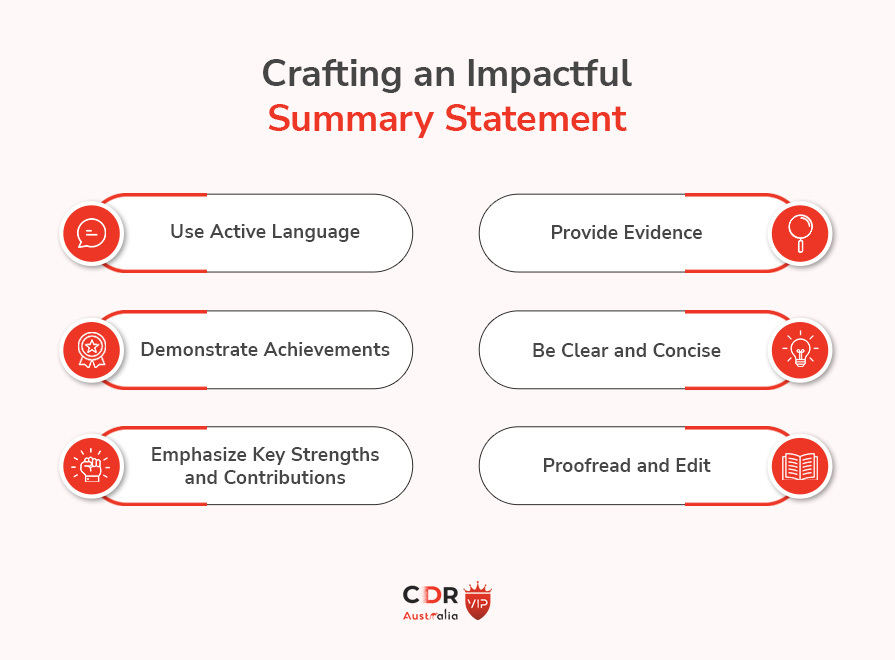How to write a professional summary statement for your CDR Report?

How to write a professional summary statement for your CDR Report?
The Competency Demonstration Report (CDR) is an essential document for engineers aspiring to migrate to Australia and seek recognition from Engineers Australia (EA). It serves as a comprehensive assessment of an engineer’s skills, knowledge, and experience.
The CDR consists of several components, including the Summary Statement, which holds immense importance. In this blog, we will delve into the intricacies of crafting an effective Summary Statement for your CDR report, ensuring that you meet the requirements set by Engineers Australia.
The CDR report is a critical document for engineers who wish to apply for skilled migration to Australia through Engineers Australia. It comprises several sections, including the Career Episodes, Continuing Professional Development (CPD) section, and the Summary Statement. The CDR report aims to demonstrate an engineer’s competency and qualifications based on the guidelines provided by Engineers Australia.
Engineers Australia sets the standards and guidelines for the CDR report to ensure that the migrating engineers meet the required competency levels in their respective engineering disciplines. Understanding the CDR report’s structure, components, and assessment criteria is crucial to crafting an effective Summary Statement.
Importance of the summary statement
The Summary Statement in the Competency Demonstration Report (CDR) holds significant importance as it bridges the Career Episodes and Engineering Competencies claimed by the engineer. It showcases the engineer’s competencies, skills, and experiences to the Engineers Australia (EA) assessors. The key reasons for its significance are:

1. Demonstration of Competencies
The Summary Statement demonstrates how the engineer has addressed the competencies outlined by Engineers Australia, showcasing their competence and proficiency levels.
2. Alignment with Occupational Category and Proficiency Levels
The Summary Statement aligns the engineer’s skills and experiences with the desired occupational category and proficiency levels of Engineers Australia.
3. Clarity and Coherence
The Summary Statement enhances clarity and coherence in the CDR report by providing a structured summary of the addressed competency elements.
4. Highlighting Key Experiences and Achievements
Engineers can emphasize their essential experiences, achievements, and contributions in the Summary Statement, effectively showcasing their capabilities.
5. Efficient Assessment Process
The Summary Statement helps assessors quickly identify the competencies addressed by the engineer, leading to a more efficient assessment process.
6. Presentation of Evidence
The Summary Statement allows engineers to present evidence from the Career Episodes, linking it to the relevant competency elements for assessors’ review.
7. Differentiation from Other Applicants
A well-crafted Summary Statement helps engineers stand out by highlighting their unique experiences, achievements, and competencies.
In conclusion, the Summary Statement is a vital component of the CDR report, demonstrating competencies, aligning skills, highlighting achievements, and facilitating a more efficient assessment process.
Read more: Top 5 facts about the Australian skilled migration assessment 💼💼
Engineers Australia’s competency elements
Engineers Australia has defined a set of competency elements that engineers need to address in their CDR report. These competency elements serve as guidelines to ensure that engineers possess the necessary skills and knowledge for the engineering occupation they are applying for.
The competency elements outlined by Engineers Australia cover various aspects, including engineering knowledge and skills, engineering application abilities, professional and personal attributes, and commitment to professional ethics and sustainability. Understanding and addressing each competency element effectively in the Summary Statement is crucial for a successful CDR report.
Structuring your summary statement
A well-structured Summary Statement is crucial for presenting your competencies effectively and ensuring clarity and coherence in your CDR report. Engineers Australia provides guidelines on structuring the Summary Statement, including using paragraphs, numbering, and cross-referencing techniques. Let’s explore the critical aspects of structuring your Summary Statement in more detail.
1. Introduction Paragraph
Start your Summary Statement with an introductory paragraph that overviews your engineering background, including your qualifications, experience, and areas of expertise. This paragraph sets the stage for the assessors and provides them context for understanding your competencies.
2. Competency Element Sections
Divide your Summary Statement into sections based on the competency elements outlined by Engineers Australia. Each section should address a specific competency element and include evidence from your Career Episodes demonstrating your proficiency. Maintaining a clear and logical flow throughout the Summary Statement is crucial.
3. Paragraph Structure
Use paragraphs to present your evidence and link it to the corresponding competency element within each competency element section. Each paragraph should emphasize a specific aspect of your experience and be concise, clear, and well-organized.
4. Numbering and Cross-referencing
Assign unique numbers to each paragraph in your Summary Statement to enhance readability and facilitate the assessors’ review. These paragraph numbers should correspond to the relevant paragraph numbers in your Career Episodes. Cross-referencing the paragraphs makes it easier for the assessors to locate the evidence supporting your claims.
For example, you can mention, “Refer to paragraph 2.3.1 in Career Episode 2 for detailed information on this project.”
5. Addressing Competency Elements
When addressing each competency element, summarize the specific knowledge, skills, and experiences related to that element. Use active language and provide specific examples that showcase your abilities. Focus on your key achievements and demonstrate how you have applied all your gained engineering knowledge and skills in real-world scenarios.
6. Coherence and Flow
Maintain a coherent and logical flow within each competency element section. Start with a clear topic sentence that introduces the paragraph’s main idea. Then, provide supporting information and evidence to validate your claims. Use appropriate transitional phrases and linking words to smooth transitions between paragraphs and sections.
7. Conciseness and Clarity
Write your Summary Statement clearly and concisely, avoiding unnecessary jargon or technical terms. Use plain language to communicate your competencies to the assessors effectively. Ensure that each sentence and paragraph contributes to the overall clarity and understanding of your Summary Statement.
8. Proofreading and Editing
Once you have structured your Summary Statement, take the time to proofread and edit your work. Eliminate any grammatical errors, typos, or inconsistencies in formatting. Pay attention to the overall coherence, clarity, and readability of your Summary Statement.
It is helpful to have a fresh pair of eyes review your work or consider engaging the services of a professional editor to guarantee the highest quality of your Summary Statement. By structuring your Summary Statement in a well-organized and coherent manner, you provide the assessors with a clear and comprehensive overview of your competencies.
Remember to follow Engineers Australia’s guidelines and utilize proper paragraphing, numbering, and cross-referencing techniques. A well-structured Summary Statement enhances the readability and impact of your CDR report, increasing your chances of a positive assessment outcome.
Read more: Top 10 reasons for CDR Rejection 💼💼
Crafting an impactful summary statement
Crafting an impactful Summary Statement requires careful consideration of various factors. Here are some tips and techniques to make your Summary Statement stand out:

a. Use active language
Write your Summary Statement using active language to develop a sense of engagement and impact. Instead of passive phrases, use active verbs to showcase your achievements and contributions.
b. Demonstrate achievements
Highlight your achievements in your Career Episodes and link them to the competency elements in the Summary Statement. Showcasing tangible outcomes and results helps validate your claims of competency.
c. Emphasize key strengths and contributions
Identify and emphasize your key strengths in the Summary Statement. Highlight your unique contributions to projects and demonstrate your ability to overcome challenges.
d. Provide evidence
The Summary Statement is not just a summary; it requires you to provide evidence of your competencies. Refer to specific paragraphs in your Career Episodes demonstrating your skills, knowledge, and experiences relevant to each competency element.
e. Be clear and concise
Write your Summary Statement clearly and concisely, avoiding excessive technical jargon. Use simple language to communicate your competencies to the assessors effectively.
f. Proofread and edit
Ensure your Summary Statement is free from grammatical errors and typos. Proofread and edit your work to maintain a professional and polished presentation.
Read More: Step-by-step process to get an Australian PR in 2023 💪💪
Avoiding common mistakes
While crafting your Summary Statement, it is crucial to avoid common mistakes that can negatively influence your CDR report. Some common mistakes include:
-
Repetition
Avoid repeating information already mentioned in your Career Episodes. The Summary Statement should provide a concise summary of your competencies, not duplicate the content of your Career Episodes.
-
Vague Statements
Be specific and provide detailed information about your experiences and achievements. Vague statements need to support evidence to weaken the impact of your Summary Statement.
-
Irrelevant Information
Focus on including only relevant information in your Summary Statement. Avoid having unnecessary details or experiences not aligning with the competency elements.
-
Lack of Clarity
Ensure your Summary Statement is clear and easily understandable. Use appropriate terminology and provide context to make your points more understandable to the assessors.
Examples of effective summary statements
To provide a practical understanding of how to craft an effective Summary Statement, let’s explore some examples from successful CDR reports:
Example 1: Competency Element: C1 – Knowledge and Skill Base Paragraph
In Career Episode 1, I successfully designed and implemented a sustainable water management system for a large-scale construction project. I demonstrated an in-depth understanding of environmental regulations, hydrological analysis, and water treatment processes. The project significantly reduced water consumption, highlighting my competence in managing water resources efficiently.
Example 2: Competency Element: C2 – Engineering Application Ability Paragraph
Throughout my Career Episode 2, I led a multidisciplinary team in developing an advanced robotic automation system for manufacturing processes. I applied my engineering knowledge and expertise to design innovative solutions that optimized production efficiency, reduced costs, and enhanced product quality. This project showcased my ability to apply engineering principles to real-world challenges effectively.
Example 3: Competency Element: C3 – Professional and Personal Attributes Paragraph
As demonstrated in Career Episode 3, my strong leadership and communication skills were pivotal in coordinating and managing a complex infrastructure project. I effectively collaborated with stakeholders, resolved conflicts, and motivated team members to achieve project objectives within stringent timelines. My capability to adapt to changing environments and inspire teamwork contributed to the successful completion of the project.
These examples illustrate how engineers can link their experiences and achievements from the Career Episodes to specific competency elements in the Summary Statement. Engineers can effectively demonstrate their competency and skills by providing clear and concise evidence.
Must Read: Top 10 most-demanded engineering fields in Australia 📚📚
Utilizing CDR Writing Services
For engineers unfamiliar with the CDR writing process or those seeking professional assistance, engaging the services of experienced CDR writers can be beneficial.
CDRAustraliaVIP offers expert guidance, personalized assistance, and access to high-quality CDR samples as references. They thoroughly understand Engineers Australia’s requirements and can help engineers craft a well-structured Summary Statement that effectively demonstrates their competencies.
CDR writing services can guide the overall structure of the CDR report, including the Summary Statement, Career Episodes, and CPD section. They can assist in identifying relevant experiences, highlighting key strengths, and ensuring the Summary Statement meets the desired competency levels.
Conclusion
An effective Summary Statement is vital for a successful CDR report submission to Engineers Australia. By following the guidelines, understanding the competency elements, and employing the techniques discussed in this blog, engineers can confidently present their skills and experiences.
Remember, a well-crafted Summary Statement demonstrates your engineering competencies and increases your chances of a positive assessment from Engineers Australia. With careful planning, attention to every detail, and the utilization of professional CDR writing services if needed, engineers can navigate the CDR process successfully and achieve their goal of migrating to Australia.

